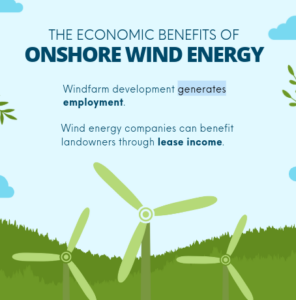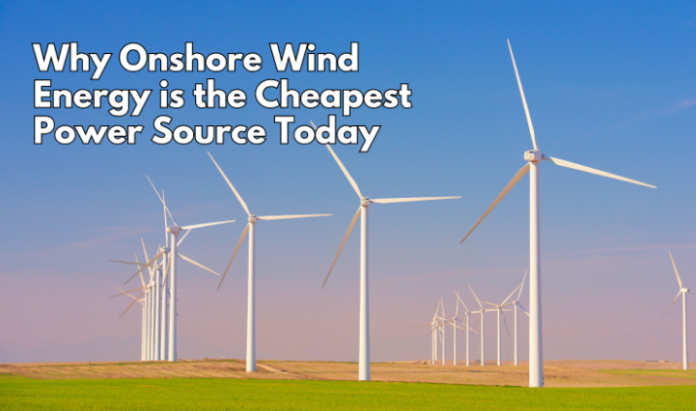Why Onshore Wind Energy is the Cheapest Power Source Today
Energy markets are shifting, and onshore wind is at the forefront. As climate change and energy insecurity remain major global issues, the search for efficient and clean energy sources has never been as important as it is today.
Out of all renewable energy types, onshore wind energy is considered the cheapest and cleanest energy source available in the modern world. This article focuses on why onshore wind power has become one of the cheapest means of power generation and the future of the industry.
The Economic Advantages of Onshore Wind Energy
Declining Costs
In particular, the cost of onshore wind energy has significantly declined over the last ten years. This is due to technology developments, scale economies, and better supply chains. The International Renewable Energy Agency (IRENA) has reported that the cost of electricity from onshore wind has declined. This trend is not expected to halt anytime soon, with further cost declines anticipated as technology advances.
The growth of onshore wind energy as the cheapest power source has various ramifications for different industries, including contact centers. Managing a contact center requires a significant amount of power for servers, telecommunication systems, and other significant equipment. Earlier, this energy demand has been fulfilled by conventional fossil fuels which can be expensive as well as unsafe for the environment. Nevertheless, the decreasing costs of onshore wind energy can offer a good solution to the problem.
Contact centers with cloud based contact center solutions can therefore realize a great number of cost reductions by moving to onshore wind energy. The cost per kilowatt-hour of wind energy is lower than that of fossil fuels, resulting in reduced energy costs and positively impacting the business’s bottom line.
Technological Innovations
On the technological side, advancements in wind turbine technology have been instrumental in the reduction of costs. New wind turbines are more productive and able to produce more electricity than older ones. Technological developments like higher towers, greater rotor diameters, and better materials have improved the efficiency of wind turbines, hence the capacity factor. These advancements have not only reduced the cost per kilowatt-hour but also made onshore wind energy competitive with conventional fuels.
Economies of Scale
The onshore wind industry has grown very fast and because of this, the cost of the industry has come down through the economies of scale. Utility-scale wind farms are advantaged by lower installation and operational costs per MW of installed capacity. Additionally, the availability of components through the global supply chain for wind turbines has become cheaper and more efficient. With more countries investing in onshore wind energy, it will further extend the economies of scale and make wind power cheaper in the future.
Environmental and Social Benefits
Low Environmental Impact
Onshore wind energy is one of the cleanest sources of energy available today. In contrast to the production of electricity using fossil fuels, wind power emits no greenhouse gasses or any other pollutants. This makes it a vital player in initiatives aimed at mitigating climate change and minimizing greenhouse gas emissions. Additionally, wind farms are not as large and intrusive as other forms of energy structures including coal mining areas and hydroelectric power dams.
Job Creation and Economic Development
Some of the benefits that have been attributed to the growth of the onshore wind industry are as follows; Wind farm development assists in the generation of employment in the manufacturing of wind turbines, construction of the farms, and maintenance, thus contributing to the employment of both the rural and the urban population.
Moreover, wind energy companies can benefit landowners through lease income, thus promoting local economic growth. Onshore wind energy’s position in the industry will continue to grow, which means that its economic value will also increase in the future.

Policy and Market Drivers
Government Incentives and Support
The market for onshore wind energy has been propelled by government policies and incentives. Feed-in tariffs, tax credits, and subsidies have been adopted by many countries in a bid to support renewable energy projects. These policies have helped bring wind power costs in line with those of conventional fossil fuel generation. Since governments across the globe remain focused on the deployment of renewable power sources, the policy framework for onshore wind is expected to remain supportive.
Corporate Demand for Renewable Energy
The corporate energy consumers have turned out to be the biggest consumers of renewable energy. Most organizations are interested in cutting down CO2 emissions and attaining environmental objectives. Consequently, they are shifting their focus towards the use of cleaner power sources, such as onshore wind, to fuel their activities.
Corporate PPAs have emerged as an attractive way for companies to access renewable energy through long-term, fixed-price contracts. Such increased demand from the corporate sector is putting more emphasis on new investments in onshore wind power.
Future Potential and Challenges
Technological Advancements and Grid Integration
The future for onshore wind energy is promising, as continuous technological innovation has the potential to make it more efficient and economical. AI and machine learning are being applied in the operations and maintenance of wind farms to enhance their effectiveness.
Overcoming Challenges
Nonetheless, onshore wind energy has some limitations that cannot be overlooked. Among them, one of the most important ones is the variability of wind power, which may result in instability of electricity production. But the situation has been compounded by the fact that energy storage technologies including batteries and pumped hydro storage are improving. Further, the construction of new transmission and distribution networks and the emergence of smart grids will also improve the reliability of wind power integration into the energy system.
The last difficulty is the influence on wildlife and local people. Wind farms can disrupt bird and bat movements, and some people may object to their construction due to noise and visual pollution. In response to these issues, developers are beginning to follow guidelines for choosing a site, designing turbines, and communicating with the public to avoid harm and gain approval.
Onshore Wind Energy and Cloud-Based Contact Center Solutions
While changes in the energy sector are occurring, the application of digital technologies in connection with renewable power sources such as onshore wind energy is gaining significance. An example of this integration is particularly notable in the handling of Cloud-based contact center solutions.
Cloud-based contact centers are crucial when it comes to customer relations and the overall flow of communication. These solutions require renewable and sustainable energy to run effectively. In this way, companies willing to lower their environmental impact and improve their sustainability profile can power cloud-based contact centers with onshore wind energy.
Conclusion
Utility-scale onshore wind power has solidified its position as the least costly type of electricity generation in the world. This makes it an important player in the energy transition given that its costs are reducing, the technology is improving, and it has numerous environmental and social advantages. With governments, corporations, and individuals worldwide emphasizing sustainability, onshore wind power is expected to grow significantly.
In addition to this, the blending of onshore wind energy with other forms of technology including cloud-based contact center solutions underlines how vital it is in the current economy. Through proper harnessing of wind energy, companies can attain environmental objectives as well as obtain efficiency from renewable energy.
In conclusion, onshore wind energy is the best economic and environmental investment for the future. Thus, as the energy markets evolve in the future, onshore wind power will continue to advance to support the world’s transition to a cleaner and more sustainable future.
FAQs
Which factors explain the reduction in the cost of onshore wind energy?
The cost of onshore wind energy has decreased due to the integration of new technologies, increased scale, and improved supply chains. IRENA shows that the cost of electricity from onshore wind has decreased by nearly 40% since 2010.
What is the implication of onshore wind energy for the environment?
Onshore wind energy provides electricity in a manner that does not release greenhouse gasses or other pollutants into the air, hence is a clean source of energy. Wind farms also occupy less space compared to other power plant infrastructures, making them less damaging to the environment.
In what way does the role of government incentives play a role in the expansion of the onshore wind energy market?
Several government policies like feed-in tariffs, tax credits, and subsidies have played a significant role in the growth of onshore wind energy. These incentives have increased the competitiveness of wind energy against fossil fuels and fostered the expansion of renewable energy projects.
